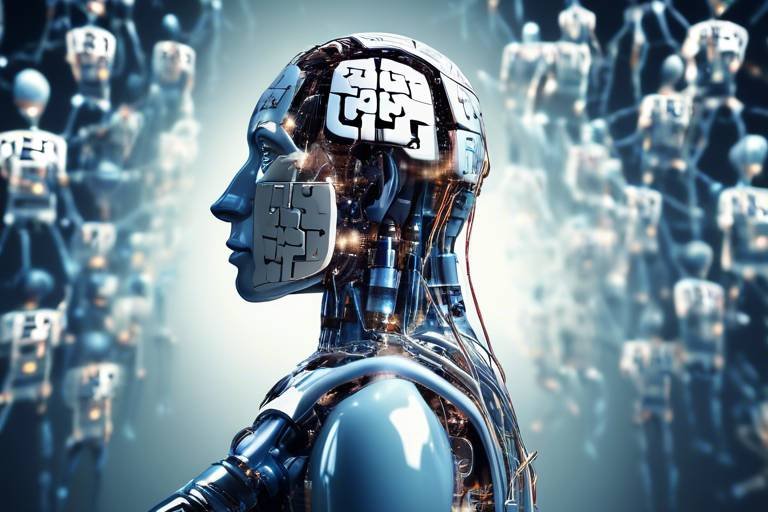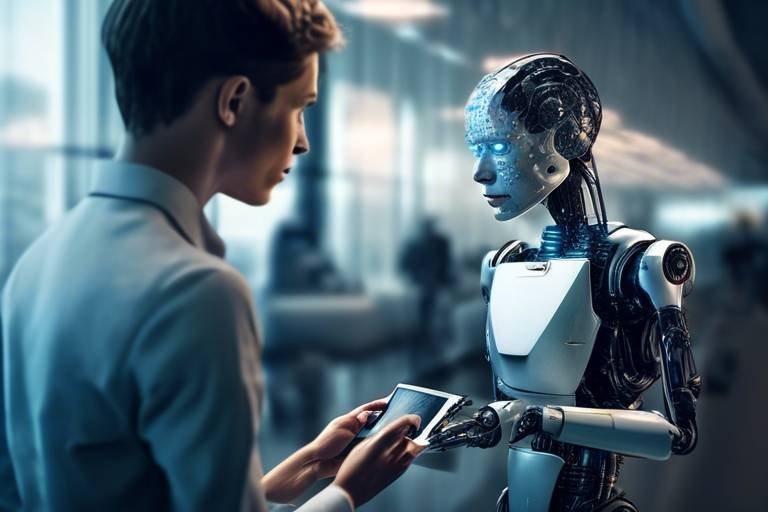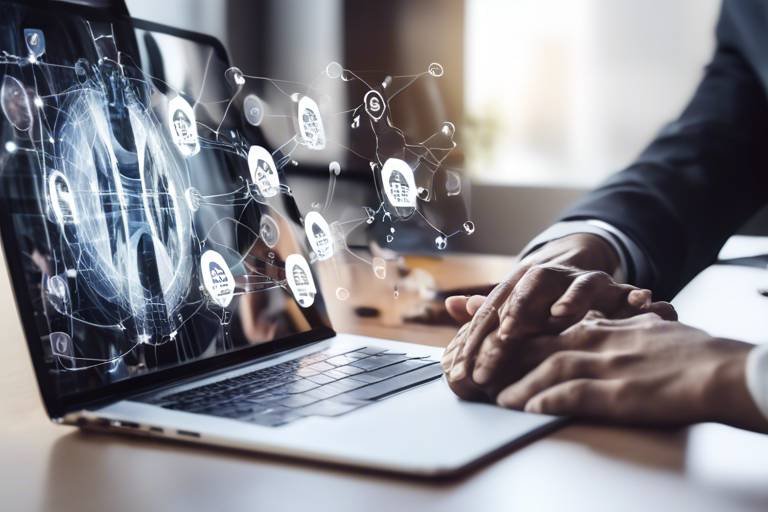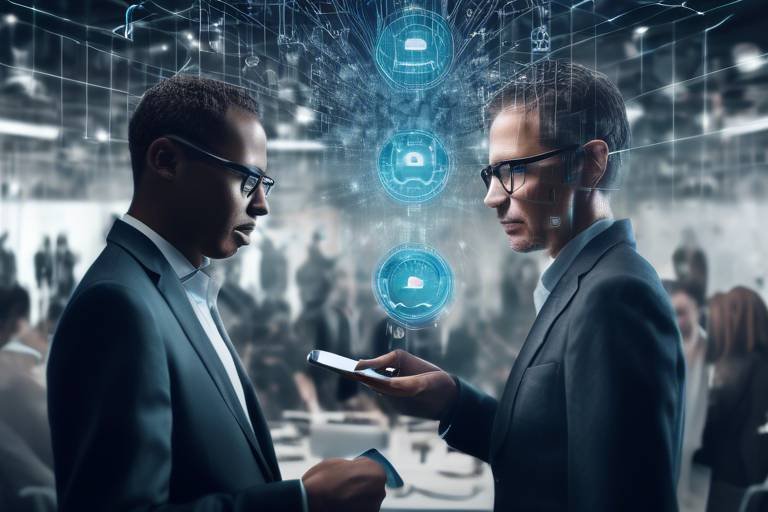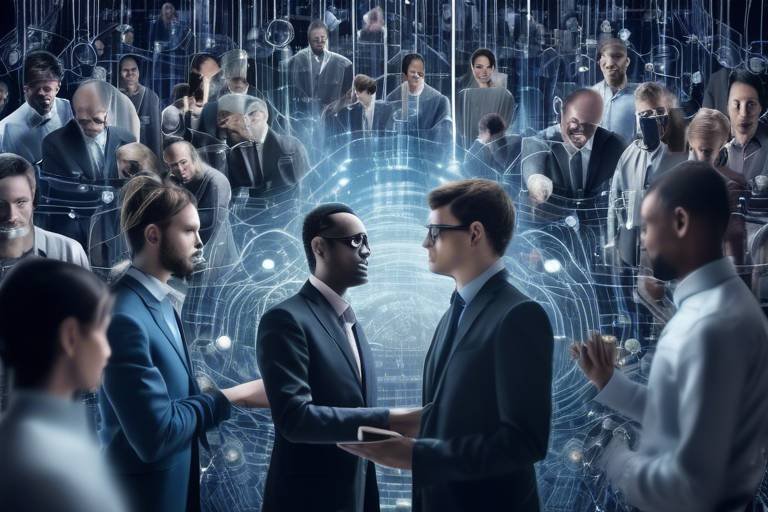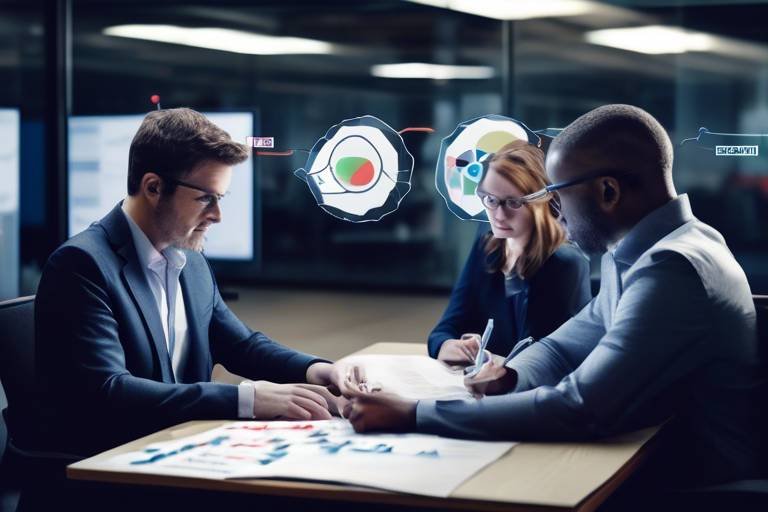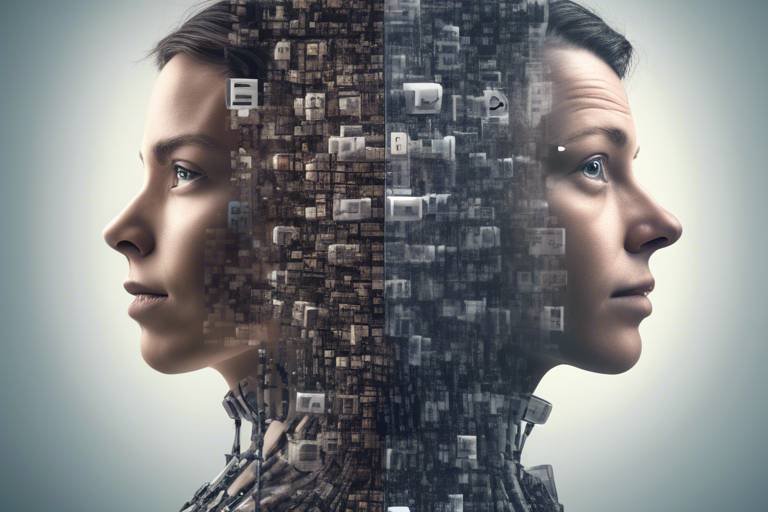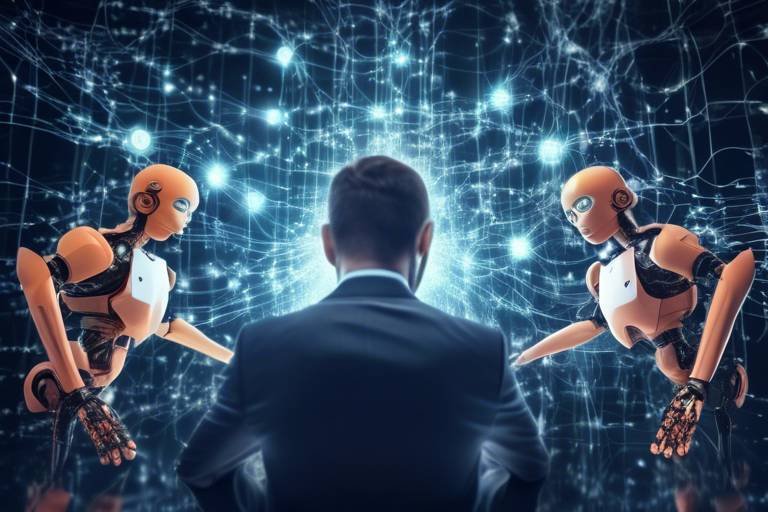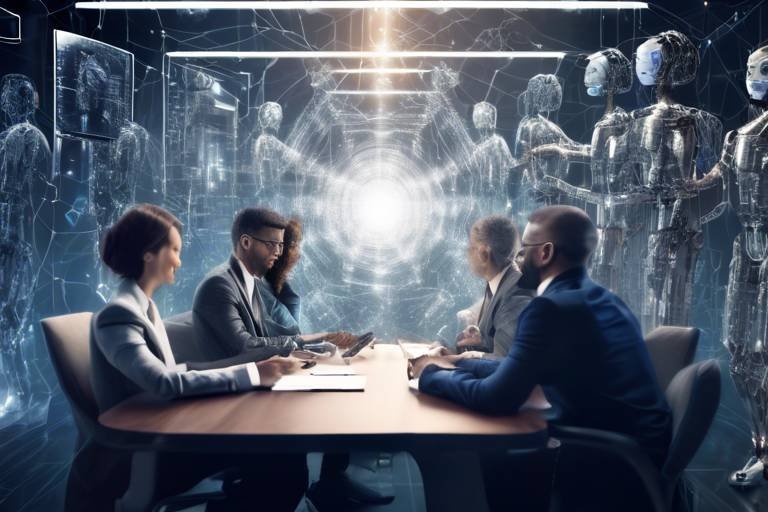Deciphering the Code: AI & Human Collaboration
In a world where technology is evolving at a breakneck pace, the relationship between artificial intelligence (AI) and human workers is becoming increasingly significant. Imagine a workplace where machines and humans work side by side, each complementing the other's strengths. This isn’t just a futuristic dream; it’s happening right now, and it’s reshaping the way we think about productivity, creativity, and problem-solving. As we dive deeper into this fascinating collaboration, we’ll explore how AI is not just a tool but a partner in various industries, enhancing our capabilities while challenging us to adapt and grow. Are you ready to uncover the layers of this partnership?
The integration of AI technologies into various industries is skyrocketing. From manufacturing to healthcare, businesses are leveraging AI to enhance productivity and streamline operations. Picture a factory floor where robots handle repetitive tasks, allowing human workers to focus on more complex problems. This isn’t science fiction; it’s the reality of modern manufacturing. Companies are using AI to analyze vast amounts of data, predict maintenance needs, and optimize supply chains. The result? Increased efficiency, reduced costs, and an overall boost in performance. The question is, how can we harness this power without losing the human touch?
When AI and humans join forces, the benefits are astounding. Together, they can tackle challenges that neither could solve alone. For instance, AI can process information at lightning speed, providing insights that help humans make better decisions. This collaboration leads to improved efficiency, as tasks that once took hours can now be completed in minutes. But it doesn’t stop there; the fusion of human intuition and AI’s analytical prowess creates a powerhouse capable of innovative solutions. Think of it as a dynamic duo: Batman and Robin, where each brings unique skills to the table.
One of the most exciting aspects of AI-human collaboration is its potential to enhance creativity. AI can analyze trends and patterns in data, offering new insights that spark human creativity. For example, in the realm of design, AI can generate multiple design options based on user preferences, allowing designers to explore new avenues they might not have considered. This synergy can lead to groundbreaking products and services that redefine industries. It’s like having a brainstorming partner who never runs out of ideas!
Real-world examples highlight the success of AI-human partnerships. In healthcare, AI systems assist doctors in diagnosing diseases by analyzing patient data more accurately and quickly than ever before. IBM Watson is a prime example, helping oncologists create personalized treatment plans based on vast databases of medical literature and patient records. Similarly, in finance, AI algorithms detect fraudulent transactions with remarkable accuracy, allowing human analysts to focus on strategic decision-making. These case studies demonstrate that when AI and humans collaborate, the results can be transformative.
The tools and technologies that facilitate AI-human teamwork are evolving rapidly. From collaborative platforms that allow teams to share insights in real time to AI-driven analytics that support informed decision-making, the landscape is rich with possibilities. For instance, software like Slack integrates AI to help teams manage projects more effectively, while platforms like Tableau use AI to visualize complex data sets. These tools empower teams to work smarter, not harder, fostering a culture of collaboration and innovation.
Despite the many advantages, challenges remain. Trust issues can arise when humans feel threatened by AI's capabilities, leading to resistance in adopting new technologies. Additionally, ethical concerns, such as bias in AI algorithms and the potential for job displacement, must be addressed. It’s crucial for organizations to foster an environment where workers feel secure and valued, ensuring that they see AI as an ally rather than a competitor. After all, collaboration thrives in a culture of trust and transparency.
As AI continues to evolve, so too will the landscape of work. The future may see humans taking on roles that require emotional intelligence, creativity, and critical thinking, while AI handles more technical, data-driven tasks. This shift necessitates a focus on reskilling and upskilling the workforce, ensuring that employees remain relevant in a rapidly changing environment. Companies that invest in their workforce will not only retain talent but also foster a culture of continuous learning and adaptation.
The rise of AI means that workers need to adapt to new technologies and workflows. Reskilling and upskilling initiatives are essential to prepare the workforce for the future. Programs that focus on enhancing digital literacy, critical thinking, and emotional intelligence will be invaluable. Organizations should consider implementing training programs that empower employees to embrace AI as a partner rather than a threat. This proactive approach will ensure that the workforce is equipped to thrive alongside AI.
As AI becomes more prevalent, ethical considerations surrounding its use are paramount. Issues such as privacy, bias, and accountability must be examined to ensure responsible collaboration. Organizations should establish clear guidelines for AI usage, prioritizing transparency and fairness. It’s vital to engage in ongoing discussions about the ethical implications of AI to build trust among employees and the public. After all, a responsible approach to AI integration will pave the way for a more equitable future.
- What is AI-human collaboration?
AI-human collaboration refers to the partnership between artificial intelligence systems and human workers, where both parties leverage their unique strengths to achieve common goals. - How does AI enhance productivity?
AI enhances productivity by automating repetitive tasks, analyzing vast amounts of data quickly, and providing insights that help humans make informed decisions. - What are the challenges of AI-human collaboration?
Challenges include trust issues, ethical concerns, and the potential for job displacement, which organizations must address to facilitate effective collaboration. - Why is reskilling important in the age of AI?
Reskilling is important to ensure that workers remain relevant and capable of collaborating effectively with AI, adapting to new technologies and workflows.

The Rise of AI in the Workplace
The integration of artificial intelligence (AI) into the workplace is not just a trend; it’s a revolution that is reshaping how businesses operate. Gone are the days when AI was merely a concept in science fiction. Today, it is a vital player across various industries, from healthcare to finance, manufacturing to retail. Companies are increasingly turning to AI technologies to enhance productivity, streamline operations, and improve customer experiences. But what does this really mean for the average worker? Let’s delve into the fascinating world of AI in the workplace.
Imagine walking into an office where mundane tasks are handled by intelligent algorithms, allowing human workers to focus on more creative and strategic endeavors. This is not a distant future; it’s happening now. AI systems are capable of processing vast amounts of data at lightning speed, providing insights that can lead to better decision-making. For instance, in the finance sector, AI can analyze market trends and predict stock movements with impressive accuracy, enabling analysts to make informed investment decisions. Similarly, in healthcare, AI assists in diagnosing diseases by analyzing medical images, thus enhancing the accuracy and speed of patient care.
As businesses embrace AI, they are discovering a myriad of applications that can significantly boost efficiency. Consider the use of chatbots in customer service. These AI-driven tools can handle multiple inquiries simultaneously, providing instant responses to customers while freeing human agents to tackle more complex issues. This not only improves customer satisfaction but also reduces operational costs. According to a recent survey, over 70% of companies reported that implementing AI solutions has led to increased productivity and reduced operational expenses.
Furthermore, AI technologies are not just about replacing human labor; they are about enhancing it. By automating repetitive tasks, AI allows employees to engage in more meaningful work. This shift can lead to a more motivated workforce, as employees are empowered to use their skills in ways that drive innovation and growth. For example, marketing teams can leverage AI to analyze consumer behavior and tailor campaigns more effectively, ultimately leading to higher conversion rates.
However, the rise of AI in the workplace also brings challenges that cannot be overlooked. As businesses integrate these advanced technologies, they must consider the implications for their workforce. Will AI displace jobs, or will it create new opportunities? This is a question that many employees are grappling with. It’s essential for companies to communicate openly about AI’s role in their operations and to provide training and resources to help employees adapt to this new landscape.
In summary, the rise of AI in the workplace is a double-edged sword. On one hand, it presents incredible opportunities for enhancing efficiency, productivity, and innovation. On the other hand, it raises important questions about job security and the future of work. As we move forward, it is crucial for businesses and employees alike to embrace this change, focusing on how AI can augment human capabilities rather than replace them.
- What industries are most affected by AI? Industries such as healthcare, finance, retail, and manufacturing are experiencing significant transformations due to AI integration.
- Will AI replace human jobs? While AI may automate certain tasks, it is also expected to create new jobs that require human skills, particularly in areas such as AI management and oversight.
- How can companies prepare their workforce for AI? Companies should invest in training and reskilling programs to help employees adapt to new technologies and roles.
- What are the ethical concerns surrounding AI? Ethical concerns include issues related to privacy, bias in algorithms, and the accountability of AI systems.

Benefits of AI-Human Collaboration
The partnership between artificial intelligence and human workers is not just a trend; it's a revolutionary shift in how we approach work and productivity. Imagine a world where machines handle the tedious tasks while humans focus on creativity and strategy. This is the essence of AI-human collaboration, where both entities bring their unique strengths to the table. The benefits of this synergy are numerous and transformative, enhancing efficiency and enabling us to tackle challenges that were once insurmountable.
One of the most significant advantages of AI-human collaboration is the improved efficiency it offers. By automating repetitive tasks, AI frees up valuable time for human workers to engage in more complex and creative activities. For instance, in the healthcare sector, AI algorithms can analyze patient data far more quickly than a human ever could, allowing doctors to spend more time on patient care and less on paperwork. This not only boosts productivity but also enhances job satisfaction, as employees can focus on what they do best.
Moreover, the integration of AI into decision-making processes leads to enhanced decision-making capabilities. AI systems can process vast amounts of data and identify patterns that might be invisible to the human eye. This capability allows businesses to make informed decisions based on real-time data analysis. For example, in the finance industry, AI can predict market trends, helping traders make better investment choices. The combination of human intuition and AI's analytical power creates a robust decision-making framework that can adapt to changing circumstances.
Another remarkable benefit is the ability to tackle complex problems through combined strengths. AI can handle large datasets and perform complex calculations, while humans can apply critical thinking and emotional intelligence. This collaboration is particularly evident in fields like environmental science, where AI models can predict climate change impacts, and human experts can devise innovative solutions to mitigate these effects. Together, they can address challenges that require both technical expertise and human empathy.
AI doesn't just improve efficiency; it also enhances human creativity. By providing new insights and inspiration, AI can help humans think outside the box. For instance, in the creative industries, AI tools can generate music, art, or even marketing content, sparking new ideas that human creators can build upon. This collaboration can lead to innovative solutions and products that would be challenging to achieve independently. Imagine a musician using AI to compose a unique melody, or a designer employing AI to suggest color palettes. The possibilities are endless!
Real-world examples of AI-human collaboration abound, showcasing the tangible benefits of this partnership. For instance, in the automotive industry, companies like Tesla utilize AI for self-driving technology while relying on human engineers for design and safety considerations. This combination has led to groundbreaking advancements in vehicle automation, setting new industry standards.
In the realm of customer service, AI-powered chatbots handle routine inquiries, allowing human agents to focus on more complex customer issues. This not only improves response times but also enhances customer satisfaction, as clients receive quicker resolutions to their problems.
To facilitate this collaboration, various tools and technologies are emerging. Collaborative platforms, such as Slack and Microsoft Teams, enable seamless communication between AI systems and human workers. Additionally, AI-driven analytics tools provide insights that support informed decision-making, empowering teams to work more effectively together. By leveraging these technologies, organizations can create a harmonious environment where AI and humans thrive side by side.
In conclusion, the benefits of AI-human collaboration are profound and far-reaching. From improving efficiency and decision-making to fostering creativity and innovation, this partnership is reshaping the future of work. As we navigate this new landscape, it's essential to embrace the strengths of both AI and human workers to unlock their full potential.
- What are the main benefits of AI-human collaboration? The main benefits include improved efficiency, enhanced decision-making, and the ability to tackle complex problems through combined strengths.
- How does AI enhance human creativity? AI provides new insights and inspiration, allowing humans to think outside the box and generate innovative solutions.
- What tools facilitate AI-human collaboration? Tools like collaborative platforms (e.g., Slack, Microsoft Teams) and AI-driven analytics are essential for effective teamwork.

Enhanced Creativity and Innovation
When you think about creativity, you might picture a lone artist in a studio, or a writer lost in thought, but the truth is that artificial intelligence (AI) is stepping into this realm in a big way. Imagine having a brainstorming partner who never runs out of ideas or a collaborator who can analyze vast amounts of data in seconds to uncover insights that spark your creativity. This is the essence of AI-human collaboration. By leveraging AI's analytical prowess and data processing capabilities, humans can enhance their own creative processes, leading to groundbreaking innovations and solutions that were previously unimaginable.
One of the most exciting aspects of this collaboration is how AI can act as a catalyst for creative thinking. For instance, AI algorithms can sift through millions of design concepts or marketing strategies, identifying trends and suggesting ideas based on what has worked in the past. This not only saves time but also opens up new avenues for exploration. Think of it as having a supercharged brainstorming session where the possibilities are endless!
Furthermore, AI can provide real-time feedback on creative projects, allowing artists, designers, and marketers to refine their work dynamically. For example, in the fashion industry, AI tools can analyze consumer preferences and predict upcoming trends, enabling designers to create collections that resonate with their target audience. This synergy between human intuition and AI analysis leads to products that are not only innovative but also aligned with market demands.
To illustrate the impact of AI on creativity, let’s consider a few key areas where this collaboration is flourishing:
- Art and Design: Artists are using AI to generate new forms of art, blending traditional techniques with digital tools to produce unique pieces that challenge conventional aesthetics.
- Music Production: Musicians are collaborating with AI to compose music, using algorithms to explore new genres and styles, thus expanding their creative horizons.
- Content Creation: Writers are utilizing AI-powered tools to generate ideas, outlines, and even entire articles, enhancing their workflow and allowing for more time to focus on the art of storytelling.
In addition to these examples, AI can also help in the innovation process by streamlining the research and development phases. Companies can use AI to simulate product performance, analyze consumer feedback, and even predict market shifts. This means that businesses can innovate faster and more efficiently, reducing the time it takes to bring new products to market.
However, it’s important to remember that while AI can enhance creativity, it should not replace the human touch. The emotional depth, intuition, and unique perspectives that humans bring to the table are irreplaceable. AI is a tool that, when used effectively, can amplify our creative capabilities rather than diminish them. So, the next time you’re brainstorming a new project, consider how AI might help unlock your creative potential and lead you to innovative solutions that could change the game.

Case Studies of Successful Collaborations
In the ever-evolving landscape of technology, the partnership between artificial intelligence and humans has led to remarkable advancements across various sectors. Let's delve into some inspiring case studies that highlight how this collaboration has not only enhanced productivity but also fostered innovation.
One standout example is the collaboration between IBM Watson and healthcare professionals. In a groundbreaking initiative, Watson was integrated into the oncology department of several hospitals, where it analyzed vast amounts of medical data and research. By doing so, it provided oncologists with tailored treatment options based on individual patient profiles. This partnership has resulted in improved patient outcomes, as doctors are now equipped with data-driven insights that enable them to make informed decisions quickly. The synergy between Watson's analytical prowess and human empathy has transformed the way cancer is treated.
Another compelling case is the use of AI in the field of finance. Companies like JP Morgan have implemented AI-driven systems to analyze market trends and assess risks. These systems can process data at lightning speed, identifying potential investment opportunities that a human analyst might miss. However, the human element remains crucial; financial advisors leverage these insights to craft personalized investment strategies for their clients. This collaboration not only enhances efficiency but also ensures that clients receive tailored advice that considers their unique financial goals.
In the realm of manufacturing, the partnership between humans and robots has revolutionized production lines. For instance, Ford has adopted collaborative robots, or cobots, that work alongside assembly line workers. These robots handle repetitive tasks, allowing human workers to focus on more complex roles that require creativity and problem-solving. This not only boosts productivity but also improves job satisfaction, as workers are no longer bogged down by monotonous tasks. The combination of human ingenuity and robotic precision has led to a more efficient and innovative manufacturing process.
To illustrate the impact of these collaborations, consider the following table summarizing key case studies:
| Industry | Company | Collaboration Details | Outcomes |
|---|---|---|---|
| Healthcare | IBM Watson | Analyzes medical data to provide treatment options | Improved patient outcomes and faster decision-making |
| Finance | JP Morgan | AI systems analyze market trends for investment strategies | Enhanced efficiency and personalized client advice |
| Manufacturing | Ford | Collaborative robots assist assembly line workers | Increased productivity and job satisfaction |
These case studies exemplify the transformative potential of AI-human collaboration. By leveraging the strengths of both parties, organizations can achieve remarkable results that neither could accomplish alone. The future looks bright as we continue to explore new ways to enhance this partnership.
- What are the main benefits of AI-human collaboration? AI-human collaboration enhances efficiency, improves decision-making, and fosters innovation by combining the strengths of both.
- Are there any risks associated with AI-human collaboration? Yes, challenges such as trust issues, ethical concerns, and potential job displacement need to be addressed for effective collaboration.
- How is AI changing the workplace? AI is streamlining operations, automating repetitive tasks, and providing data-driven insights, allowing humans to focus on more complex and creative work.

Tools and Technologies Enabling Collaboration
In today's fast-paced world, the collaboration between artificial intelligence and human workers is not just a trend; it's a necessity. The tools and technologies that facilitate this partnership are evolving rapidly, providing a robust framework for effective teamwork. From collaborative platforms to AI-driven analytics, these innovations are designed to support informed decision-making and enhance productivity.
One of the most significant advancements in this area is the rise of collaborative software. Tools like Slack, Microsoft Teams, and Trello allow teams to communicate seamlessly, share ideas, and manage projects efficiently. These platforms integrate AI features that help prioritize tasks, suggest deadlines, and even analyze team performance. Imagine having a virtual assistant that not only organizes your schedule but also reminds you of important deadlines based on your team's workload. This is the power of AI in collaborative tools!
Furthermore, AI-driven analytics provide insights that were previously unattainable. By analyzing vast amounts of data, AI can identify trends and patterns that help teams make more informed decisions. For instance, a marketing team can leverage AI analytics to understand customer behavior better, allowing them to tailor their campaigns more effectively. This not only enhances the team's creativity but also drives innovation, as they can experiment with new ideas based on data-backed insights.
Another exciting area is the development of virtual collaboration spaces. With advancements in augmented reality (AR) and virtual reality (VR)
In addition to these tools, machine learning algorithms are increasingly used to enhance project management. By predicting potential roadblocks and suggesting optimal workflows, AI can help teams navigate complex projects with greater ease. For example, an AI system might analyze previous project data to recommend the best approach for current tasks, ensuring that human workers can focus on their strengths while AI handles the heavy lifting.
As we look to the future, it's clear that the combination of human creativity and AI's analytical power will redefine the workplace. The tools that enable this collaboration are not just about making work easier; they are about unlocking new potentials and driving innovation. The synergy created by these technologies allows teams to tackle challenges that were once deemed insurmountable, paving the way for a more productive and creative workforce.
- What are some popular collaborative tools that integrate AI? Tools like Slack, Microsoft Teams, and Trello have integrated AI functionalities to enhance team communication and project management.
- How does AI improve decision-making in teams? AI analyzes large data sets to identify trends and provide insights that help teams make informed decisions based on real-time data.
- Can AI replace human workers in collaborative tasks? While AI can automate certain tasks, it is designed to augment human capabilities, allowing for a more effective collaboration rather than replacement.

Challenges in AI-Human Collaboration
As we dive deeper into the world of AI-human collaboration, it's essential to acknowledge that this partnership is not without its hurdles. While the integration of artificial intelligence into the workplace presents numerous opportunities, it also brings forth a set of challenges that can hinder effective collaboration. One of the most significant issues is the trust factor. How can humans trust AI systems to make decisions that impact their work and lives? This question lingers as we see AI algorithms making choices based on data that may not always be transparent. The fear of the unknown can create resistance among employees, leading to a reluctance to embrace AI technologies.
Moreover, ethical concerns are at the forefront of the conversation around AI. As AI systems are designed to learn and adapt, they can inadvertently perpetuate biases present in their training data. This raises questions about accountability and fairness. For instance, if an AI system makes a biased hiring decision, who is responsible? The developers, the company, or the AI itself? These ethical dilemmas require careful consideration and clear guidelines to ensure that AI-human collaborations do not lead to unintended harmful consequences.
Another challenge is the looming threat of job displacement. Many fear that as AI systems become more capable, they will replace human jobs, leading to significant unemployment. While it's true that AI can automate routine tasks, it also creates new roles that require human oversight and creativity. The key lies in understanding how to leverage AI to complement human skills rather than replace them. This shift in perspective is crucial for fostering a collaborative environment where both AI and humans can thrive.
Furthermore, the skills gap presents a barrier to effective collaboration. Many workers may not possess the necessary skills to work alongside AI systems, leading to a disconnect between human capabilities and technological advancements. Companies must invest in training programs to ensure their workforce is equipped with the skills needed to collaborate effectively with AI. This includes not only technical skills but also soft skills such as adaptability and critical thinking.
In summary, while the collaboration between AI and humans holds great promise, it is accompanied by challenges that must be addressed. Building trust, navigating ethical concerns, mitigating job displacement fears, and bridging the skills gap are all critical components in fostering a successful partnership. By acknowledging and tackling these challenges head-on, we can pave the way for a future where AI and humans work together harmoniously, enhancing productivity and innovation across various sectors.
- What are the main challenges in AI-human collaboration?
The primary challenges include trust issues, ethical concerns, job displacement fears, and the skills gap among workers. - How can companies address the skills gap?
Companies can invest in training programs to equip their workforce with the necessary skills to work alongside AI systems. - Are there ethical concerns related to AI?
Yes, ethical concerns include biases in AI systems and accountability for decisions made by AI. - Will AI replace human jobs?
While AI may automate certain tasks, it also creates new roles that require human oversight and creativity.

The Future of Work with AI
As we stand on the brink of a new era, the future of work with AI is not just a passing trend; it's a transformative journey that redefines how we perceive our roles in the workplace. Imagine a world where mundane tasks are automated, allowing humans to focus on what truly matters—creativity, strategy, and emotional intelligence. This isn't science fiction; it's the reality we are rapidly approaching. The integration of AI into our work environments promises to enhance productivity while also shifting the dynamics of job responsibilities.
One of the most intriguing aspects of this future is the potential for collaboration between humans and AI systems. Rather than viewing AI as a replacement for human workers, we should consider it a powerful ally. Together, they can tackle complex challenges that neither could solve alone. For instance, while AI can process vast amounts of data at lightning speed, humans bring critical thinking and contextual understanding to the table. This synergy can lead to groundbreaking innovations and solutions that can revolutionize entire industries.
However, with this exciting future comes a pressing need for reskilling and upskilling. As AI takes over repetitive and routine tasks, workers must adapt by acquiring new skills that complement AI capabilities. This will not only ensure job security but also empower employees to thrive in a tech-enhanced environment. Companies will need to invest in training programs that focus on developing soft skills, creative problem-solving, and advanced technical skills to prepare their workforce for the changes ahead.
To illustrate this point, consider the following table that highlights potential job roles and the skills required in an AI-driven future:
| Job Role | Skills Required |
|---|---|
| Data Analyst | Data interpretation, critical thinking, AI tool proficiency |
| AI Ethics Consultant | Ethical reasoning, policy analysis, communication |
| Creative Strategist | Creative thinking, collaboration, digital marketing skills |
| AI Trainer | Technical skills, human-AI interaction, adaptability |
As we embrace this future, we must also grapple with significant ethical considerations. The rise of AI brings forth questions about privacy, bias, and accountability. For instance, how do we ensure that AI systems are fair and unbiased? What measures are in place to protect user data? These questions will not only shape the policies governing AI but also influence public trust in these technologies. It is crucial for organizations to establish transparent practices and prioritize ethical standards in their AI integration efforts.
In conclusion, the future of work with AI is a landscape filled with opportunities and challenges. By fostering a culture of collaboration and continuous learning, we can harness the power of AI to enhance our work experience rather than diminish it. It’s about embracing change, adapting to new realities, and ensuring that we remain at the forefront of innovation. The key to success lies in our ability to evolve alongside these technologies, turning potential threats into opportunities for growth and advancement.
- Will AI replace human jobs? While AI will automate certain tasks, it will also create new job opportunities that require human skills.
- What skills will be most important in the future? Skills such as creativity, emotional intelligence, and advanced technical abilities will be crucial in an AI-driven workplace.
- How can companies prepare their workforce for AI integration? Companies should invest in training programs that focus on reskilling and upskilling employees to work effectively with AI technologies.
- What ethical concerns should we consider with AI? Issues such as privacy, bias, and accountability must be addressed to ensure responsible AI use.

Reskilling and Upskilling the Workforce
As artificial intelligence (AI) continues to permeate every corner of our workplaces, the conversation around reskilling and upskilling the workforce has never been more critical. Imagine a world where employees are not just surviving but thriving alongside advanced AI systems. This isn't just a dream; it's becoming a reality. Companies are realizing that to harness the full potential of AI, they must invest in their human capital. But what does this investment look like?
First, let's break down what we mean by reskilling and upskilling. Reskilling refers to training employees to take on new roles, often in response to the changing technological landscape. For instance, a factory worker might learn to operate new robotic machinery. On the other hand, upskilling involves enhancing an employee's existing skills to improve their performance in their current role. Think of it as polishing a diamond to make it shine even brighter.
With AI automating routine tasks, the need for human workers to adapt is paramount. Companies are increasingly offering training programs that focus on both hard and soft skills. Hard skills might include learning to use new software or understanding data analytics, while soft skills could encompass leadership, communication, and teamwork. These dual focuses ensure that employees are not only technically proficient but also equipped to work collaboratively with AI systems.
Moreover, the benefits of reskilling and upskilling extend beyond individual employees. Organizations that prioritize continuous learning and development create a culture of innovation and adaptability. This culture not only attracts top talent but also enhances employee retention. Workers who feel valued and invested in are more likely to stay with a company, reducing turnover costs and maintaining institutional knowledge.
To illustrate the impact of these initiatives, consider the following table that outlines the potential benefits of reskilling and upskilling:
| Benefit | Description |
|---|---|
| Increased Job Satisfaction | Employees feel more competent and valued, leading to higher morale. |
| Enhanced Productivity | Skilled employees can work more efficiently, leveraging AI tools effectively. |
| Future-Proofing | Preparedness for future technological advancements reduces the risk of obsolescence. |
| Stronger Company Reputation | Companies known for investing in employee development attract better talent. |
However, the journey of reskilling and upskilling isn't without its challenges. Employees may feel apprehensive about returning to the classroom or may question the relevance of new skills in their current roles. Therefore, it’s crucial for organizations to foster an environment that encourages learning and experimentation. By integrating training into the work culture, companies can alleviate fears and promote a growth mindset.
In conclusion, as we navigate this new era of AI integration, the importance of reskilling and upskilling cannot be overstated. Organizations that recognize and act on this need will not only enhance their operational efficiency but also empower their workforce to embrace the future with confidence. After all, in a world increasingly driven by technology, the true competitive advantage lies in our ability to adapt and evolve.
Q: What is the difference between reskilling and upskilling?
A: Reskilling involves training employees for new roles, while upskilling enhances their existing skills for improved performance.
Q: Why is reskilling important in the age of AI?
A: As AI automates tasks, reskilling ensures that employees can take on new responsibilities and remain valuable in the workforce.
Q: How can companies encourage a culture of continuous learning?
A: Companies can offer training programs, provide resources for self-learning, and create an environment that rewards curiosity and innovation.

Ethical Considerations in AI Integration
As we dive deeper into the world of artificial intelligence, ethical considerations become more crucial than ever. It's like navigating a complex maze; each turn presents new challenges and dilemmas that we must address to ensure a harmonious integration of AI into our daily lives. One of the primary concerns is privacy. With AI systems collecting vast amounts of data to function effectively, how do we protect individuals' personal information? The balance between leveraging data for improved services and safeguarding privacy is a tightrope walk, requiring transparent policies and robust security measures.
Another pressing issue is bias. AI algorithms are often trained on historical data, which can inadvertently perpetuate existing prejudices. Imagine a scenario where an AI system makes hiring decisions based on biased training data; this could lead to unfair treatment of candidates from certain backgrounds. To combat this, developers must prioritize diversity in their training datasets and continuously monitor AI outputs for signs of bias, ensuring that fairness is embedded in the AI's decision-making process.
Moreover, the question of accountability looms large. When an AI system makes a mistake—say, misdiagnosing a medical condition—who is responsible? Is it the developer, the user, or the AI itself? This ambiguity necessitates clear guidelines and frameworks to establish accountability, ensuring that there is a human element in the decision-making process, even when machines are at the helm.
In addition to these concerns, the potential for job displacement raises ethical questions about the future of work. As AI takes over repetitive tasks, we must consider the impact on the workforce. It's essential to develop strategies for reskilling and upskilling employees, enabling them to transition into new roles that AI cannot easily replicate. This proactive approach not only mitigates the risks of job loss but also empowers workers to thrive in an AI-enhanced environment.
Ultimately, the integration of AI into our lives is a double-edged sword. While it promises remarkable advancements and efficiencies, we must tread carefully, addressing these ethical considerations to foster a future where AI and humanity can coexist and collaborate effectively. By doing so, we can harness the full potential of AI while upholding our values and principles.
- What are the main ethical concerns regarding AI? The main concerns include privacy, bias, accountability, and job displacement.
- How can we ensure AI systems are fair? By using diverse training datasets and continuously monitoring AI outputs for bias.
- Who is responsible when AI makes a mistake? Responsibility can fall on developers, users, or the AI itself, highlighting the need for clear accountability frameworks.
- What should companies do to mitigate job displacement? Companies should invest in reskilling and upskilling programs for their employees.
Frequently Asked Questions
- What is AI-human collaboration?
AI-human collaboration refers to the partnership between artificial intelligence technologies and human workers. This collaboration aims to enhance productivity, improve decision-making, and solve complex problems by combining the strengths of both parties.
- How is AI being integrated into the workplace?
Businesses are increasingly leveraging AI to streamline operations and boost efficiency. This integration includes using AI for data analysis, automating routine tasks, and enhancing customer experiences through personalized recommendations.
- What are the benefits of AI-human collaboration?
Collaborating with AI can lead to improved efficiency, better decision-making, and the ability to tackle intricate challenges. Additionally, AI can augment human creativity, providing fresh insights and inspiration that can drive innovation.
- Can you provide examples of successful AI-human collaborations?
Absolutely! One notable example is in the healthcare sector, where AI assists doctors in diagnosing diseases more accurately. Another example is in marketing, where AI analyzes consumer data to help teams create more effective campaigns.
- What challenges do we face in AI-human collaboration?
Some significant challenges include trust issues between humans and AI systems, ethical concerns regarding bias and privacy, and the potential for job displacement as AI takes on more tasks traditionally performed by humans.
- How will AI affect the future of work?
The future of work will likely involve a greater reliance on AI, with humans focusing on tasks that require emotional intelligence, creativity, and complex problem-solving. Reskilling and upskilling will be essential to ensure workers can effectively collaborate with AI.
- What is the importance of reskilling and upskilling in the age of AI?
As AI continues to evolve and take on more responsibilities, reskilling and upskilling become crucial for workers to stay relevant. This ensures that they possess the necessary skills to work alongside AI technologies and adapt to changing job demands.
- What ethical considerations should be taken into account with AI integration?
When integrating AI, it's vital to consider ethical issues such as privacy, bias in algorithms, and accountability for AI-driven decisions. Addressing these concerns is essential for fostering responsible collaboration between humans and AI.


